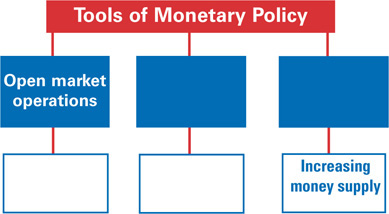Chapter 16 Assessment
Chapter Summary
A summary of major ideas in Chapter 16 appears below. See also the Guide to the Essentials of Economics, which provides additional review and test practice of key concepts in Chapter 16.
-
Section 1 The Federal Reserve System (pp. 415–418)
To stabilize the nation's banking system, Congress created the Federal Reserve System. The Federal Reserve is made up of twelve Federal Reserve Districts and is overseen by a small but powerful Board of Governors. As a private institution serving a public function, the Federal Reserve is a central bank relatively free from government control.
-
Section 2 Federal Reserve Functions (pp. 420–423)
The Federal Reserve serves the banking needs of the government and of individual banks. It regulates the nation's banking system. It also monitors and regulates the nation's money supply.
-
Section 3 Monetary Policy Tools (pp. 425–429)
Money creation occurs through the day-to-day operations of banks. The Federal Reserve uses three tools of monetary policy to control the amount of money in circulation. The three tools are changing the required reserve ratio, changing the discount rate, and buying or selling bonds on the open market.
-
Section 4 Monetary Policy and Macroeconomic Stabilization (pp. 430–434)
The Federal Reserve enacts monetary policy to lessen the effects of business cycles. The unpredictable length of business cycles, however, makes it difficult to determine when it is wise to intervene in the economy. Inside lags and outside lags make it difficult to conduct monetary and fiscal policy.
Key Terms
Match the following definitions with the terms listed below. You will not use all of the terms.
- inside lag
- discount rate
- Board of Governors
- federal funds rate
- excess reserves
- Federal Reserve District
- tight money policy
- money creation
- outside lag
- easy money policy
- prime rate
- check clearing
- Rate the Federal Reserve charges for loans to commercial banks
- Process by which money enters into circulation
- The seven-member board that oversees the Federal Reserve System
- Monetary policy that reduces the money supply
- Reserves greater than the required amounts
- The process by which banks record whose account gives up money and whose account receives money when a customer writes a check
- The time it takes for monetary policy to have an effect
Using Graphic Organizers
On a separate sheet of paper, copy the tree map below. Complete the tree map with the tools of monetary policy and their expected effects on the economy.





